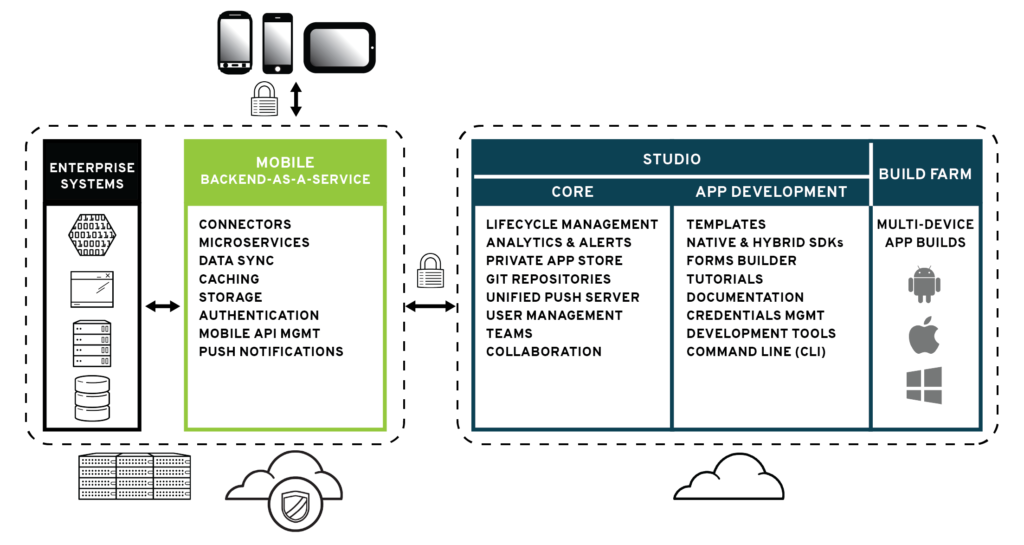At Red Hat Mobile, we have been working hard over the last several months on exciting new technologies. Today we are happy to announce the general availability of Red Hat Mobile Application Platform 4.0.
Following the success of our Hosted offering, we have taken the next step in the advancement of our product. Let's take a moment to recap on a couple of key technology choices we made over 5 years ago that have proven to be visionary decisions for the architecture of a mobile platform.
- Node.js was chosen a long time ago (in Node years) at the beginning of 2011. Our flexible Node.js-powered Mobile Backend-as-a-Service (MBaaS) lets you build fast and lightweight event-driven business logic and microservices that can interact with enterprise systems or cloud services on one side, and mobile apps on the other. We have seen the exponential adoption rate of Node.js since then and over 200K modules in the NPM ecosystem. We have also grown our team of top notch Node.js expert Engineers.
- Another key technology decision was the use of Linux containers for the deployment and execution of cloud apps and microservices in the MBaaS. This allowed us to have greater flexibility to build Application Lifecycle Management capabilities to manage code between development environments and cloud resources.
Without a doubt technology decisions that have been key to the success of Red Hat Mobile Application Platform (RHMAP).
Fast-forward to today, our team has done it again! In RHMAP 4.0 we are incorporating industry-leading Container management capabilities with OpenShift Enterprise by Red Hat, leveraging both docker containers and Kubernetes orchestration. All of this is running on a foundation of Red Hat Enterprise Linux (RHEL) 7.2. The MBaaS becomes the first Mobile Backend-as-a-Service in the market fully supported from the ground up starting with RHEL, Red Hat Software Collections, and taking our expertise in the use of containers to the next level with Docker and Kubernetes.
Let’s dive a little deeper on what these new technologies mean for mobile app development in the RHMAP MBaaS. Docker container formats make deployments more repeatable and secure; you can have greater app density per VM; you use fewer computing resources; and large community ecosystem of products and services are available as Docker images.
With the new Kubernetes orchestration we go from handling hundreds of containers to a proven technology that can handle thousands or even millions of containers (Red Hat and Google have contributed greatly to the Kubernetes project). This is the best technology to orchestrate apps and services that span multiple containers, provide separation per environment and manage container health to detect and automatically restart containers on failure.
Underpinning this new release is the use of OpenShift Enterprise for the MBaaS, giving us one more important differentiator: the ability to have the application data, runtime and integrations deployed outside of our hosted service, for example, on-premise. This means that RHMAP 4.0 has a new deployment model, where the development and management of apps occurs in the multi-tenant cloud instance of the RHMAP Core hosted by Red Hat whilst the application data, runtime, and integrations are deployed to the MBaaS installed anywhere, for example in an enterprise data center. The cloud applications deployed in an MBaaS can make use of RHMAP APIs, such as data synchronization, authentication or caching, and integrate with enterprise systems or other cloud services.
With this deployment option we take Enterprise Mobility to the next level, enterprises can:
- Store sensitive data and intellectual property in their own data centres
- Have better control of network latency on private environments
- Gain 100% control over service, location, regulations
- Exercise greater flexibility with own resources
- Leverage existing on-premise infrastructure and resources
While we are going to continue with the same developer features in our RHMAP Hosted product, RHMAP 4.0 becomes an ideal option for enterprises interested in moving to the cloud but worried about sensitive data being accessed from the public cloud. In many cases organizations have IT policies that mandate keeping integrations with enterprise systems behind firewalls and they mandate full control and management of their infrastructure. This new model brings the best of both worlds, gaining app development productivity in the public cloud; access from anywhere; git repositories; online collaboration; and the benefit of constant releases with access to up-to-date features in a cloud-based core platform, not feasible on self-hosted systems. It is really a perfect combination between public and private hosting.
The hosted RHMAP Core remains the same for both deployment options, hosted version 3.x and now 4.0 with the MBaaS component outside the core platform.
We'll be talking more about RHMAP 4.0 at Red Hat Summit in San Francisco on June 28th.
Start exploring today, there are many ways to learn more about RHMAP 4.0
Last updated: June 13, 2024

